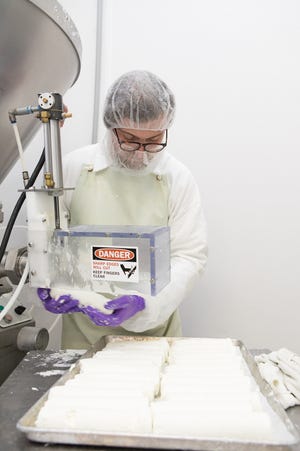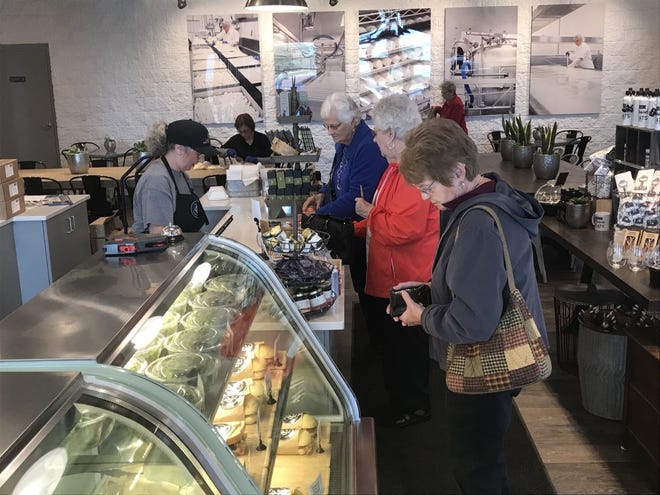Say Cheese! With $10M investment, LaClare Creamery is ready for its close-up
 Colleen Kottke
Colleen Kottke
While dairy producers struggle with falling demand for milk, consumers' appetite for Chevre cheese continues to increase.
Sales of the soft goat milk cheese have grown by leaps and bounds, says Bill Ritcey, vice president of sales at LaClare Family Creamery.
"We weren't making Chevre three years ago and now it's one of the fastest growing cheeses in the country," Ritcey said. "The demand is so great that we are up 308% in sales and our plans for next year are similar to that."
The runaway demand for this versatile goat cheese was the impetus behind the $10 million expansion of LaClare Family Creamery now poised to become a national leader in Chevre cheese production.
The creamery, established in 1979 by Larry and Clare Hedrich, essentially doubles its operational footprint with the 28,000-square-foot addition. The expansion was made possible by a collaboration between the Hedrich family and Kaukauna-based Milk Source, bringing the resources for the creamery's expansion and future capital investment.
RELATED: From two goats to award-winning cheese
Fresh, close and plenty
Since 2016, the Chilton Dairy goat farm – owned by Milk Source and located just 10 miles away in neighboring Calumet County – has been a major supplier of milk to LaClare Farms. Prior to that, LaClare had been struggling to find enough milk to meet the growing customer demand.
"Milk Source has a reputation for first-class milk production; LaClare is world renowned for its quality cheesemaking – so the combination of talent and vision came naturally to both," said Avi Stern, director of public affairs for Milk Source. "They have the know-how, the heritage, the tradition and people and we have the top-quality milk."
According to the U.S. Department of Agriculture's latest Census of Agriculture, dairy goat herds expanded faster than any other major livestock group over the past decade. In the last four years, the greater Malone area has become what Clara Hedrich coins as the "mecca of the dairy goat world in the U.S."

Between Chilton Dairy (5,000 goats) and Drumlin Dairy (8,000 goats) – located just 7 miles apart in the town of Brotherton – those two operations house over 20 percent of the state's dairy goats. And according recent data from the USDA, Wisconsin leads the nation in its inventory of dairy goats at 72,000 head, with runner up California trailing at 42,000.
RELATED: New dairy goat farms catering to market demands
"The growing desire for dairy goat products in the U.S. — combined with the ability of this region to meet that demand — makes us uniquely positioned to satisfy customers," Ritcey said.
Including Chilton Dairy, there are nine local goat farms that supply 40,000 to 50,000 lbs. of milk to LaClare Family Creamery each day. LaClare also collects cow milk for Saxon Creamery from two pasture-grazed herds for the Saxon brand and LaClare's blended goat/cow milk blend cheeses.
"One of the things that separates the product that comes out of here is the closeness of our milk supply," Ritcey said. "This is Goat Central USA. We have goat milk just 35 minutes away from here. The less that milk has to be transported and agitated, the better your cheese product is going to be."
When making cheese, the quality of milk is paramount, said LaClare cheesemaker Jennifer Kutz. That quality was proven this past summer at the Wisconsin State Fair when LaClare's low-fat goat milk won First Place and Best of Class (cow or goat's 2% milk division) in the Wisconsin Dairy Products Contest.
"Our goat milk is known for its fresh, clean flavor. That means you can expect superior quality and taste from all our cheeses," she said.

A versatile winner
Known for its delicate, fresh buttery taste profile, the versatile Chevre cheese is like a blank canvas waiting to be transformed into countless creations by adding flavors or pairing it with other foods.
"It's not just cheese and crackers anymore. People are experimenting with it and using it as an ingredient for many different kinds of dishes," Ritcey said.
Several times a year, the creamery introduces new palate-pleasing Chevre flavors that include Maple Bourbon, Honey, Blueberry, Cranberry & Cinnamon, Garlic & Herb, Everything Bagel Spice and more.
"Chevre is like a gateway goat cheese. And if we make an amazing Chevre and they like that, maybe they're willing try other goat milk cheeses, like cheddar," Kutz said.

Ritcey believes the public is developing a taste for new and different cheese products with an international flair. And with a more than ample supply of fresh goat's milk, the company is more than able to meet that robust market demand.
"The biggest challenge of any manufacturer is to keep up with the marketplace and recognize where it's going and to be there when it gets there," Ritcey said. "We have complete confidence in the Chevre business and believe we're just seeing the tip of the iceberg."
RELATED: Wisconsin is America's Dairy-goat land
Related:Visitor center is educational gem in heart of goat country
Last year, LaClare Family Creamery teamed up with fellow Wisconsin artisanal cheesemaker Saxon Creamery and Verona, Penn.-based Italian Creamery, Lamagna Cheese, to form Mosiac Meadows, a partnership that allows each operation to sell, service and market nationwide.
State-of-the-art investments
To meet the demand for quality Chevre cheese, the expansion includes investments in maturation tanks where the goat milk is cultured for about 16 hours before moving to the imported French Cheese Presses. The cheese curds are then loaded into 100 individual cloth bags. As the bags are gently pressed together, the whey drains out during a six-hour period, allowing the cheese to maintain its texture.
The cheese is then loaded into a large mixer where it is cooled and then moved to a vat where salt and flavoring are added. The blended cheese is dumped into an extruder, where it is formed into logs and packaged in various sizes for both retail and food service markets.

"That allows us to be even more innovative in developing and introducing sophisticated flavors today's consumers are looking for," Kutz said.
State-of-the-art air-handling equipment keeps the large production room at a chilly 45 degrees and maintains proper humidity to "create the perfect Chevre-making environment," said Adam Schrot, LaClare plant manager.
Future expansion
John Sharp, project manager for the expansion, says the plant was built with future expansion in mind.
"There's at least three other phases where we could add on to the plant, plus with the space we have inside, we could expand our ability to produce cheese two and a half times, and with the efficiencies we have, that could go up to five times," he said.
The project also included a top-down redesign of the retail and dining space where guests can purchase anything from toasted sandwiches featuring LaClare or Saxon brand cheeses, or goat milk ice cream cones or chewy caramels.
LaClare also produces a line of traditional cheese such as mozzarella, jack and cheddar made of goat's milk as well as blended cheese products made with both goat and cow's milk.
A unique mezzanine also allows visitors to take a self-guided tour; learn about animal care and cheesemaking; and enjoy a bird's-eye view of the plant so they can witness milk being transformed into cheese.
Science and art
At the helm of that transformative process at LaClare are the cheesemakers that are involved from the moment the fluid milk arrives in the semi until the finished product rolls out the door and off to market.

Among those cheesemakers is Kutz who served as an apprentice under the watchful eye of Katie Fuhrmann, the Hedrich's daughter and U.S. Champion cheesemaker.
Taking over Fuhrmann's place, Kutz has learned that making great cheese is not just about using fresh milk, but paying attention to the details.
"Every one of those details — down to the minute, down to the ounce — matters," she said. "Cheesemaking is both a science and an art. I'm not a scientist, I'm an artist.
“But if I focus enough on the art or the human touch of making cheese, then the science just happens," she said.
Kutz credits the success of the operation to everyone involved in the process: from the farm, to the staff inside the plant to the sales and marketing team traveling across the U.S. helping LaClare to become a nationally known brand.
"We have a passion for the goat milk products and have set the bar high," Kutz said. "Right now, we're in an experimental phase where people are more into trying new things. And that's a great time and opportunity for us as a business."
If you go
The LaClare Family Creamery re-grand opening will be held from 11 a.m. to 3 p.m. Saturday, Oct. 19.
The event will feature self-guided tours of the new visitor center as well as viewing of new baby goats.
Visitors will also have the opportunity to meet the creamery's cheesemakers and sample goat milk and cow milk cheese samples, along with a cheese carving demonstration.
Grilled cheese sandwiches made with goat and cow's milk cheese will also be available for sale at reduced prices.
The creamery is located at W2994 County Hwy. HH, Malone, WI, just off Highway 151, 14 miles north of Fond du Lac.